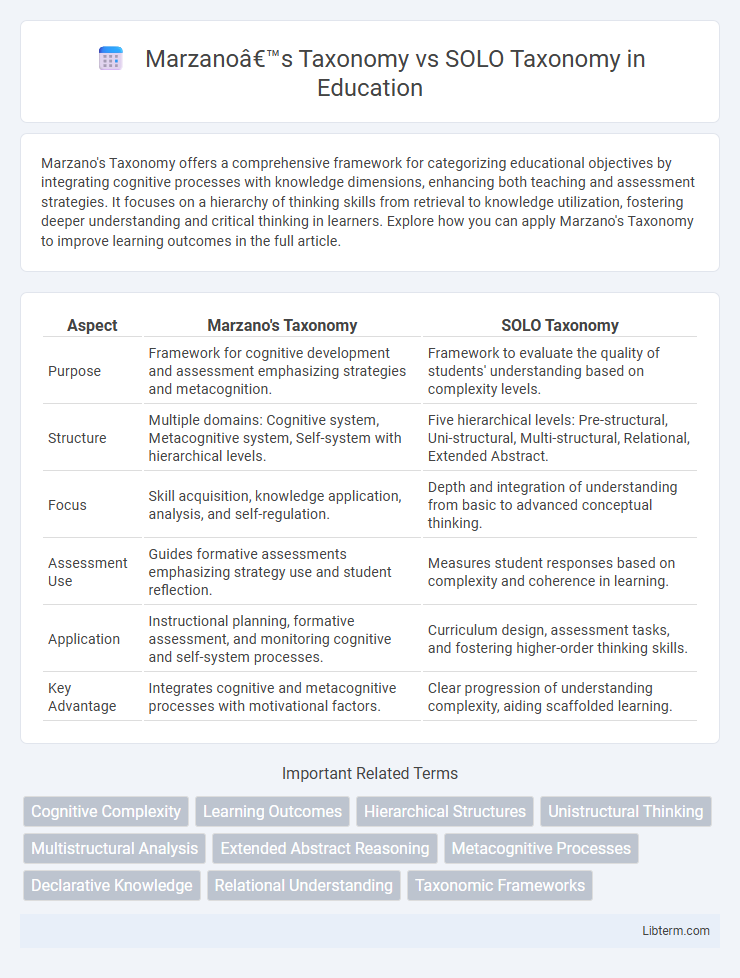Marzano's Taxonomy offers a comprehensive framework for categorizing educational objectives by integrating cognitive processes with knowledge dimensions, enhancing both teaching and assessment strategies. It focuses on a hierarchy of thinking skills from retrieval to knowledge utilization, fostering deeper understanding and critical thinking in learners. Explore how you can apply Marzano's Taxonomy to improve learning outcomes in the full article.
Table of Comparison
| Aspect | Marzano's Taxonomy | SOLO Taxonomy |
|---|---|---|
| Purpose | Framework for cognitive development and assessment emphasizing strategies and metacognition. | Framework to evaluate the quality of students' understanding based on complexity levels. |
| Structure | Multiple domains: Cognitive system, Metacognitive system, Self-system with hierarchical levels. | Five hierarchical levels: Pre-structural, Uni-structural, Multi-structural, Relational, Extended Abstract. |
| Focus | Skill acquisition, knowledge application, analysis, and self-regulation. | Depth and integration of understanding from basic to advanced conceptual thinking. |
| Assessment Use | Guides formative assessments emphasizing strategy use and student reflection. | Measures student responses based on complexity and coherence in learning. |
| Application | Instructional planning, formative assessment, and monitoring cognitive and self-system processes. | Curriculum design, assessment tasks, and fostering higher-order thinking skills. |
| Key Advantage | Integrates cognitive and metacognitive processes with motivational factors. | Clear progression of understanding complexity, aiding scaffolded learning. |
Introduction to Educational Taxonomies
Educational taxonomies such as Marzano's Taxonomy and SOLO Taxonomy provide frameworks for categorizing learning objectives and outcomes to enhance instructional design and assessment. Marzano's Taxonomy emphasizes cognitive systems, knowledge domains, and mental processes, offering a detailed, hierarchical approach to student thinking and comprehension. SOLO Taxonomy, or Structure of Observed Learning Outcomes, categorizes learning from surface to deep understanding, focusing on how learners organize knowledge, making it a valuable tool for evaluating the quality and complexity of student responses.
Overview of Marzano’s Taxonomy
Marzano's Taxonomy organizes cognitive skills into three systems: Self-System, Metacognitive System, and Cognitive System, emphasizing the interaction between emotional and cognitive processes in learning. It categorizes knowledge into four domains -- Information, Mental Procedures, Physical Procedures, and Knowledge Utilization -- promoting deeper understanding beyond rote memorization. This taxonomy supports differentiated instruction by addressing students' motivation, metacognition, and complex thinking skills in a comprehensive framework.
Core Structure of SOLO Taxonomy
SOLO Taxonomy centers on the hierarchical levels of understanding, progressing from Pre-structural to Extended Abstract, which guides educators in assessing the complexity of students' responses. The core structure emphasizes the qualitative differences in learners' comprehension, contrasting with Marzano's Taxonomy that organizes cognitive processes and knowledge dimensions into discrete, actionable categories. SOLO's layered framework facilitates deeper insights into conceptual grasp and knowledge integration, promoting targeted instructional strategies based on the sophistication of student learning outcomes.
Key Principles Behind Marzano’s Approach
Marzano's Taxonomy emphasizes cognitive complexity through hierarchical knowledge domains: retrieval, comprehension, analysis, knowledge utilization, and metacognition, focusing on active student engagement and self-regulation strategies. It integrates metacognitive skills to foster deeper understanding and the application of knowledge across contexts. Marzano's approach contrasts with SOLO Taxonomy by prioritizing explicit cognitive processes and strategic thinking within learning tasks.
SOLO’s Hierarchical Levels Explained
SOLO Taxonomy categorizes learning outcomes into five hierarchical levels: Pre-structural, Unistructural, Multistructural, Relational, and Extended Abstract, each representing increasing complexity and integration of knowledge. These levels guide educators in assessing the depth of student understanding, from grasping isolated facts to synthesizing new insights. In contrast to Marzano's Taxonomy, which emphasizes cognitive processes and skills, SOLO focuses on the qualitative structure of student responses, making it a powerful tool for evaluating the coherence and sophistication of learning.
Comparing Cognitive Processes in Both Taxonomies
Marzano's Taxonomy organizes cognitive processes into retrieval, comprehension, analysis, knowledge utilization, and metacognition, emphasizing structured skill development and application. SOLO Taxonomy categorizes understanding into pre-structural, uni-structural, multi-structural, relational, and extended abstract levels, highlighting increasing complexity and integration of knowledge. While Marzano focuses on actionable cognitive skills for learning tasks, SOLO emphasizes progressive depth and interconnectedness of student responses.
Application in Classroom Assessment
Marzano's Taxonomy emphasizes specific cognitive skills like retrieval, comprehension, analysis, and application to design classroom assessments that measure students' mastery progressively. SOLO Taxonomy categorizes student responses into levels such as pre-structural, uni-structural, multi-structural, relational, and extended abstract to evaluate the depth of understanding in assessments. Applying both taxonomies enables educators to create assessments that not only check factual knowledge but also assess the complexity and integration of student learning effectively.
Strengths and Limitations of Marzano’s Taxonomy
Marzano's Taxonomy strengths include its detailed breakdown of cognitive processes into retrieval, comprehension, analysis, knowledge utilization, and metacognition, providing educators with precise instructional guidance and assessment design. Its limitation lies in the complexity and overlap of categories, which can challenge implementation and may require extensive teacher training to apply effectively in diverse classroom settings. Unlike the more hierarchical SOLO Taxonomy, Marzano's framework emphasizes practical skill application but may lack the clear developmental stages of learning progression.
Advantages and Drawbacks of SOLO Taxonomy
SOLO Taxonomy offers a clear framework for assessing student understanding by categorizing learning outcomes from surface to deep knowledge, facilitating targeted teaching strategies. Its advantage lies in promoting higher-order thinking skills and providing easily interpretable feedback for both educators and learners. However, SOLO Taxonomy can be limited by its less detailed guidance on instructional design compared to Marzano's Taxonomy, and it may require more training for teachers to implement effectively.
Selecting the Right Taxonomy for Effective Learning
Marzano's Taxonomy emphasizes cognitive processes such as retrieval, comprehension, analysis, and knowledge utilization, making it ideal for structuring detailed lesson objectives and assessments. SOLO Taxonomy focuses on the quality of student responses by progressing through levels of complexity from unistructural to extended abstract understanding, which benefits formative assessment and deep learning evaluation. Selecting the right taxonomy depends on the learning goals: Marzano's supports clear cognitive skill development, while SOLO enhances conceptual understanding and metacognition.
Marzano’s Taxonomy Infographic

 libterm.com
libterm.com